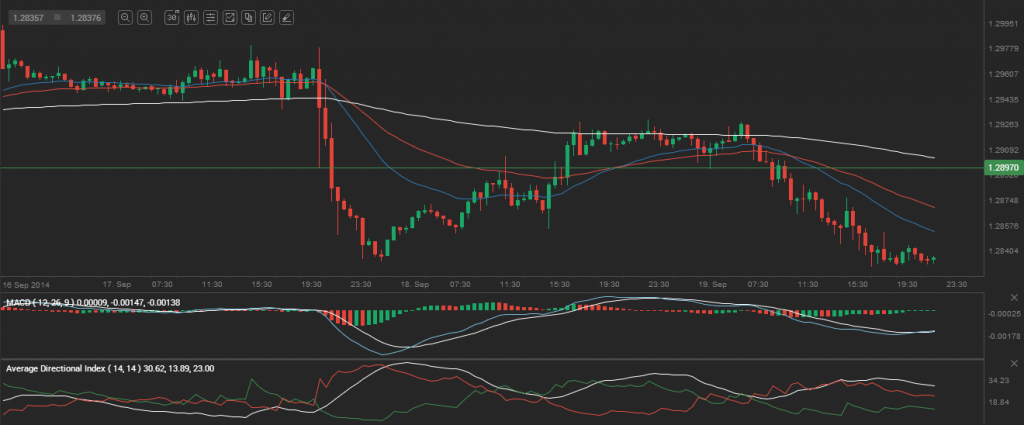Friday’s trade saw EUR/USD within the range of 1.2826-1.2929. The pair closed at 1.2829, losing 0.73% on a daily basis and 1.05% for the whole week.
Fundamental view
Euro zone
Italian Industrial New Orders
At 8:00 GMT Italy’s National Institute of Statistics is expected to release a report on industrial new orders in July. The annualized new orders (without a seasonal adjustment) dropped 2.5% in June, while in monthly terms the indicator registered a 2.1% decrease. It measures the change in value of new orders, received by industrial sector companies, for delivering a variety of products. Only enterprises with over 20 employees are included in the survey. New orders are closely related with future industrial activity. In case the indicator drops in value, this might have a limited bearish effect on the euro.
Euro zone Consumer Sentiment
Sentiment in the Euro region probably continued to worsen in September, with the corresponding index coming in at a reading of -10.75, according to the median forecast by experts. In August the index stood at -10, which has been the lowest level since February.
The Economic Sentiment Indicator (ESI) reflects the level of optimism, which consumers have about economic development. The survey is conducted by phone and includes 23 000 households in the Euro zone. The questions asked stress on current economic and financial situation, savings intention and also on expected developments regarding consumer price indexes, general economic situation and major purchases of durable goods. The indicator measures consumer confidence on a scale of -100 to +100. A reading of -100 suggests a lack of confidence, zero means neutrality and a reading of +100 indicates extreme levels of confidence. Lower confidence usually implies lesser willingness to spend, including large-ticket purchases, while consumer spending is a key factor behind economic growth. Therefore, in case the ESI fell more than anticipated, this would mount selling pressure on the euro. The European Commission is expected to release the preliminary reading at 14:00 GMT.
United States
Sales of existing homes
The index of existing home sales in the United States probably gained 0.3% to a level of 5.20 million in August compared to July. In July compared to June existing home sales rose 2.4% to 5.15 million, or the highest level since September 2013. The sample of data encompasses condos, co-ops and single-family houses.
Statistical data on existing home sales is often used along with statistical figures regarding the new home sales and pending home sales, with the major objective being to draw a conclusion how nation’s housing sector is performing, regardless of interest rates. The most active house-purchasing period in the United States is usually between the months of March through June. Therefore, in case statistical data revealed a sudden drop in the number of homes sold rather than an improvement during this period, this would be considered as a signal of weakness in country’s housing market.
The report on existing home sales usually does not cause a real direct impact on US economy. Actually, this effect appears to be minimal, due to the fact that nothing is produced with the mere sale of an existing home. In terms of economic activity, the sale of an existing house may be related only to interior design and purchases of new furniture.
The reason markets pay a certain attention to existing home sales report is that it reveals much about the general course of nation’s economy. A major part of the population considers a house as a sign of wealth and, unlike the money wealth, which is concentrated in certain regions of the country and held by the wealthiest representatives of the population, ”housing wealth” is evenly distributed across the country.
In case the index increased more than anticipated, this would have a bullish effect on the US dollar. The National Association of Realtors (NAR) is to release the official figure at 14:00 GMT.
Technical view
According to Binary Tribune’s daily analysis, the central pivot point for the pair is at 1.2861. In case EUR/USD manages to breach the first resistance level at 1.2897, it will probably continue up to test 1.2964. In case the second key resistance is broken, the pair will probably attempt to advance to 1.3000.
If EUR/USD manages to breach the first key support at 1.2794, it will probably continue to slide and test 1.2758. With this second key support broken, the movement to the downside will probably continue to 1.2691.
The mid-Pivot levels for Monday are as follows: M1 – 1.2725, M2 – 1.2776, M3 – 1.2828, M4 – 1.2879, M5 – 1.2931, M6 – 1.2982.
In weekly terms, the central pivot point is at 1.2883. The three key resistance levels are as follows: R1 – 1.2940, R2 – 1.3051, R3 – 1.3108. The three key support levels are: S1 – 1.2772, S2 – 1.2715, S3 – 1.2604.






